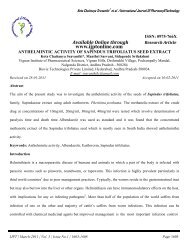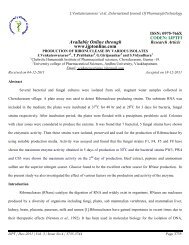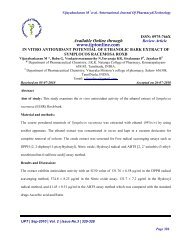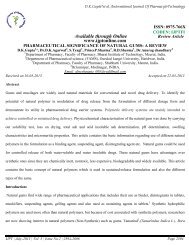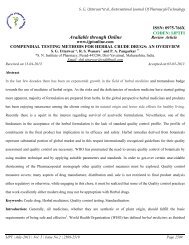Available Online through www.ijptonline.com
Available Online through www.ijptonline.com
Available Online through www.ijptonline.com
Create successful ePaper yourself
Turn your PDF publications into a flip-book with our unique Google optimized e-Paper software.
3.4. IR-spectra<br />
R. Rajavel* et al. /International Journal Of Pharmacy&Technology<br />
The IR spectra of the reported <strong>com</strong>pounds were measured as KBr disk and the important IR-spectral feature along<br />
with their tentative assignments are given in Table-II. In the spectrum of the <strong>com</strong>plexes the absence of band in the<br />
region ∼3400cm -1 corresponding to free primary amine suggests that <strong>com</strong>plete condensation of amino group with<br />
diketone group. The disappearance of these band and the appearance of a new strong absorption band near 1586-<br />
1600cm -1 confirms the formation of the Schiff base, as this band assigned to ν(C=N) stretching vibration[19]. The<br />
data in Table.2. display that frequency value of the ν(C=N) is lower value of ν(C=N) stretching energy may<br />
explained on the basis of a drift of the lone pair density of the azomethine nitrogen towards the central metal<br />
atoms[20, 21], indicating that the coordination takes place <strong>through</strong> the nitrogen atom of the (C=N) group. Thus, it<br />
appears that each diketone molecule has reacted with the amino groups of the 3,3’-diaminobenzidine with<br />
phthalaldehyde forming the Schiff base and the diaminonaphthalene is used for ring closure and giving rise to<br />
macrocyclic metal <strong>com</strong>plex molecule. The presence of acetate in <strong>com</strong>plexes 1&2 is evidenced by two medium<br />
absorption features centered at 1610 cm −1 for ν as (COO) and 1450 cm −1 for ν sy (COO). The difference between (ν as -<br />
ν sy ) is around 160 cm −1 agrees with the coordination mode for the acetate ion with the central metal ion[22, 23, 24].<br />
All of the perchlorate salts show a medium band near 1145-1190 cm −1 and a strong band at 1085-1109 cm −1 and<br />
sharp band at 621-626 cm −1 , indicative of uncoordinated perchlorate anions[25- 28]. For vanadyl <strong>com</strong>plexes, a strong<br />
band observed at 980 cm −1<br />
is assigned to ν(V=O) which rules out the possibility of a dimeric structure[29].<br />
Conclusive evidence of the bonding is also shown by the observation that new bands in the IR- spectra of the metal<br />
<strong>com</strong>plexes appear at 460-501 cm −1 assigned to ν(M-N) stretching vibrations[30]. Thus from the IR- spectra it is clear<br />
that the <strong>com</strong>pounds may be bonded to the metal ions <strong>through</strong> the imine nitrogen.<br />
3.5. Cyclic Voltammetry studies<br />
The electrochemical behavior of the <strong>com</strong>plexes was examined by employing a platinum electrode as working<br />
electrode, Ag/AgCl as a reference electrode and platinum wire as auxiliary electrode. The working media consisted of<br />
IJPT | April-2012 | Vol. 4 | Issue No.1 | 4018-4031 Page 4024



